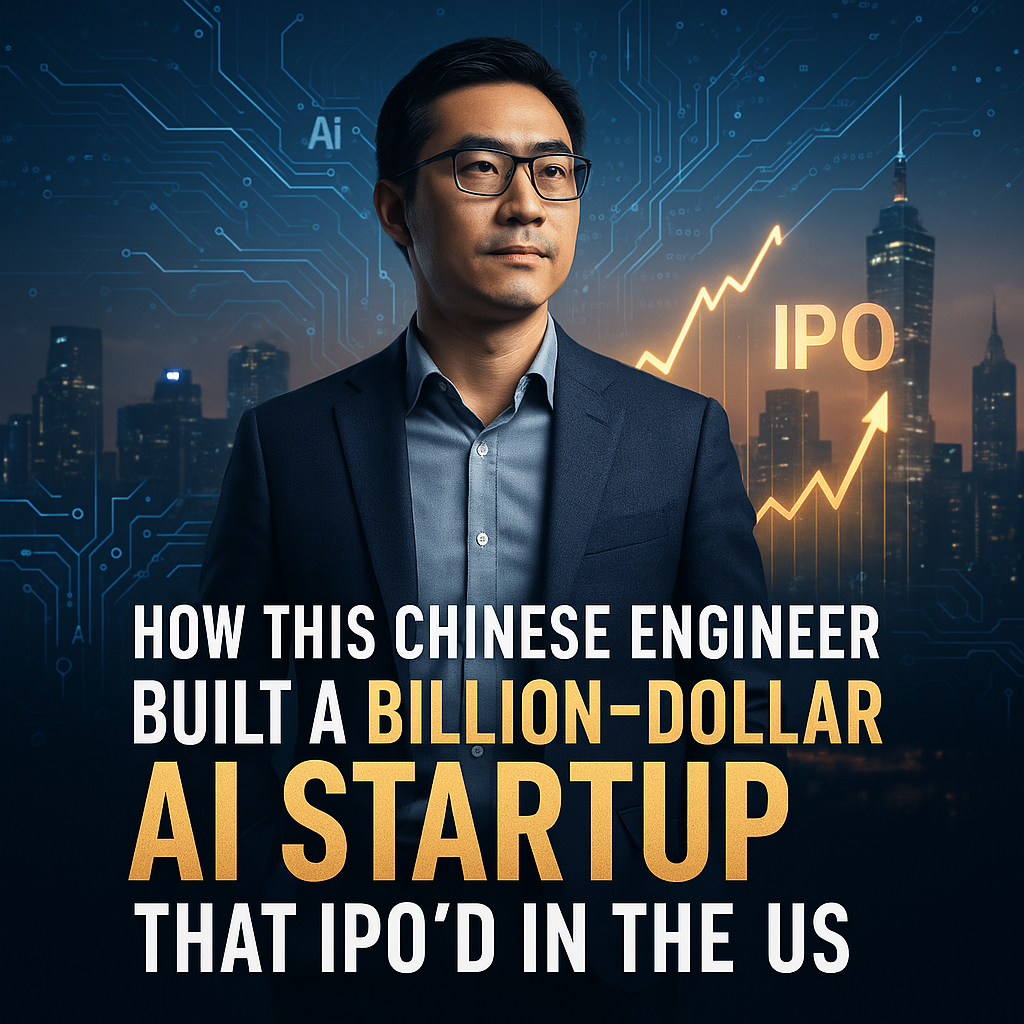How This Chinese Engineer Built a Billion-Dollar AI Startup That IPO’d in the US
Introduction: The Birth of Liulishuo
The story of how a brilliant Chinese engineer transformed an innovative idea into a billion-dollar AI startup is truly remarkable.
Ben, a talented engineer with a strong technical background, co-founded a company called LAIX, which offers a product known as Liulishuo in China and LingoChamp internationally.
The name Liulishuo literally means “speak fluently” in Chinese, perfectly capturing the essence of this language learning platform.
Meanwhile, LingoChamp combines “Lingo,” a Latin prefix for language, with “Champ,” short for champion – creating an appealing brand for overseas markets.
For consumer products, having the right name is crucial, often accounting for about 50% of potential success according to industry experts.
Consider the brilliant translation of Coca-Cola in Chinese as “Ke-Kou-Ke-Le,” which essentially means “delicious and happiness” while maintaining similar phonetics to the original name.
This attention to branding details demonstrates the thoughtful approach that successful entrepreneurs like Ben take when developing products for different cultural markets.
We strongly recommend that you check out our guide on how to take advantage of AI in today’s passive income economy.
Table of Contents
The AI Education Vision: Timing is Everything
In the startup world, ideas themselves hold little value compared to timing and execution.
Computer-aided learning isn’t a novel concept – Steve Jobs famously envisioned this future during a 1984 Playboy interview, predicting that every student would eventually have an Apple computer, revolutionizing education.
While his prophecy of widespread computer access eventually came true, technology alone couldn’t transform education as dramatically as anticipated.
The concept of using advanced technology to enhance education has persisted throughout computing history, but implementation has faced numerous challenges.
For Liulishuo, success came from launching at precisely the right moment – during the mobile internet boom, which truly put computing devices into everyone’s hands for the first time.
Unlike in America, where personal computers were common in homes, many Chinese citizens skipped the PC era entirely, moving directly to mobile devices.
This mobile revolution created the perfect foundation for an app-based language learning solution that could reach millions of users who previously lacked access to technology-enhanced education.
Deep Learning Revolution: The Technical Edge
The second critical timing element was the emergence of deep neural networks and deep learning.
Around 2010, researchers began to recognize the potential of neural networks, though the concept itself wasn’t new.
Pioneering AI researchers like Ilya Sutskever were already understanding the importance of scaling laws – that larger models with more data would produce dramatically better results.
However, at that time, computing power limitations prevented full realization of these scaling advantages.
Nevertheless, deep neural networks were already showing impressive results in specific domains, particularly speech recognition – a technology directly applicable to language learning.
By leveraging these advances in speech recognition, Liulishuo could create a mobile app that could effectively listen to users’ pronunciation, evaluate it, and provide feedback.
This combination of the mobile revolution and deep learning advancements created the perfect technological environment for an AI-driven language learning platform to thrive.
Entrepreneurial Background: Learning from Failure
Interestingly, Liulishuo wasn’t Ben’s first entrepreneurial endeavor.
In 2011, he launched a personal search engine startup, conceptually similar to what many AI companies are developing today with personal knowledge bases and personalized AI search.
This first venture didn’t succeed, but it demonstrated Ben’s forward-thinking approach, as he was conceptualizing personalized search a decade before today’s AI boom made it technically feasible.
As Ben explains, startup ideas often resurface cyclically, returning every 10-20 years when technology advances sufficiently to make implementation viable.
This perspective highlights an important lesson for entrepreneurs: being too early to market can be just as challenging as being too late.
The progression from failed first startup to successful second venture underscores the importance of persistence and learning from experience – qualities that define successful entrepreneurs regardless of cultural background.
Cultural Context: Risk-Taking in Chinese Society
When examining entrepreneurship in East Asian societies, we must consider cultural attitudes toward risk-taking.
Traditionally, East Asian cultures including China, Japan, and Korea have emphasized job security and stable career paths over entrepreneurial risk.
However, Ben challenges the notion that stable employment is inherently superior, noting that startup founding isn’t appropriate for everyone.
From a purely financial perspective, most people would earn more through traditional employment than by founding startups, given the high failure rate of new ventures.
Ben’s willingness to take entrepreneurial risks stemmed partly from his exposure to programming in college, where he discovered the joy of creating something from nothing.
His time in Silicon Valley’s entrepreneurial ecosystem further influenced his mindset, though he maintains that educational background and location are less important than timing and personal determination.
Many successful Chinese startup founders never studied abroad, yet built remarkable companies by capitalizing on the right market conditions at the right time.
Educational Journey: From China to Silicon Valley
Ben’s educational path took him from Chinese universities to graduate studies in America.
Initially enrolled in a PhD program in the United States, he eventually left academia to join a startup in New York before returning to China.
At that time, obtaining scholarships for American graduate education was challenging for Chinese students, though in recent years, increasing wealth among Chinese families has made self-funded overseas education more common.
Historically, Chinese graduate students have constituted the largest group of foreign graduates in American universities, particularly in STEM fields.
This educational migration occurred because research capabilities at Chinese institutions were previously less developed than their Western counterparts.
However, this dynamic has shifted as young professors educated abroad have returned to China, strengthening research programs at Chinese universities.
Today, many top Chinese students choose to remain in China for graduate studies, joining research groups that now compete at the highest international levels.
The Birth of Liulishuo: Perfect Timing
Upon returning to China, Ben immediately began working on his first startup, which ultimately failed.
In 2012, he co-founded LAIX (Liulishuo), which proved more successful due to its excellent market timing.
Remarkably, Liulishuo and Duolingo were developed almost simultaneously without knowledge of each other – Duolingo launched in late 2012, with Liulishuo following in February 2013.
While Duolingo offered multiple languages to cater to American users who primarily wanted to learn languages other than English, Liulishuo focused exclusively on English education for Chinese speakers – the largest sector in language learning globally.
This market-focused approach targeted a massive existing demand, previously served by numerous offline English tutoring schools throughout China.
By moving this educational experience to mobile devices and enhancing it with AI technology, Liulishuo made English learning more accessible and convenient while reducing dependence on human teachers.
Product Innovation: Gamification Meets AI
When Liulishuo launched in February 2013, it achieved immediate popularity.
The product incorporated extensive gamification elements – similar to Duolingo’s approach – applying proven game design principles to make language learning more engaging and habit-forming.
Combined with cutting-edge speech recognition technology and thoughtful user experience design, these gamification elements created a compelling product that quickly gained traction.
Users would practice speaking English with the app, receive scores based on pronunciation accuracy, and share their achievements on Weibo (China’s equivalent to Twitter), creating organic viral growth.
This social sharing component accelerated adoption, quickly propelling Liulishuo to the top-ranked position among learning apps in Chinese app stores.
It even reached the number one position among all free apps for a period, demonstrating extraordinary market penetration and user engagement.
Funding Journey: Capital Efficiency
Unlike many Chinese internet companies that raised billions in venture capital, Liulishuo maintained relative capital efficiency throughout its growth.
The company raised less than $200 million total, including IPO proceeds – a modest sum compared to China’s food delivery or ride-hailing companies, which required massive capital for market share battles and subsidized pricing.
Liulishuo’s business model was inherently more capital-efficient, allowing the company to grow substantially with comparatively modest investment.
This capital efficiency stemmed from focusing on a clear value proposition – English language education – rather than competing in winner-take-all markets requiring enormous subsidies.
The company benefited from China’s mature venture capital ecosystem, which by 2012 had already developed structured funding stages from incubators and angel investors through to late-stage growth capital.
Talent Acquisition: Building on Giants’ Shoulders
Liulishuo wasn’t part of the first wave of Chinese internet startups, which provided some advantages in talent acquisition.
Earlier successes like Alibaba, Baidu, and Tencent had already trained a generation of skilled engineers through real-world experience building systems for hundreds of millions of users.
These companies had developed robust infrastructure and trained engineers capable of handling massive scale, creating a talent pool that newer startups could tap into.
While Liulishuo’s founding team had American education backgrounds and recruited some talent from abroad, most of their engineering team came from the domestic talent pool.
This blend of internationally-educated leadership and locally-trained technical talent created a strong foundation for building sophisticated AI systems adapted to Chinese user needs.
Startup Reality: The Emotional Journey
Despite Liulishuo’s success, Ben describes the startup journey as far from smooth.
He suggests that the happiest moment in building a startup often comes before product launch – the period of pure creativity and anticipation, when founders are focused solely on building the best possible product without external pressures.
After launch, reality sets in – user feedback (both positive and negative), feature requests, technical issues, and eventually revenue pressures as investors expect monetization after initial growth.
The startup journey involves continuous ups and downs, with internal debates about direction and strategy that outsiders never see.
What appears as smooth success from the outside often feels like “a war every day” internally, with difficult decisions and constant challenges.
This reality check is valuable for aspiring entrepreneurs who might romanticize the startup experience based on public success stories.
IPO Journey: A Major Milestone
After years of growth, Liulishuo’s board decided to pursue an initial public offering in the United States.
The company completed the IPO process in less than six months, ringing the bell at the New York Stock Exchange on September 27, 2018.
The timing proved fortunate, as they experienced the traditional IPO ceremony in person – something many companies missed during the COVID-19 pandemic, when IPO ceremonies became virtual.
Ben describes feeling intensely emotional during the bell-ringing ceremony, but notes that these feelings dissipated almost immediately afterward, as his mind turned back to business operations and ongoing challenges.
This emotional transition highlights an important truth about entrepreneurship – major milestones like IPOs are moments to appreciate, but they’re not endpoints.
The business continues with new responsibilities and challenges, particularly as a public company with quarterly reporting requirements and shareholder expectations.
Financial Perspective: Beyond Money
While financial success is an obvious outcome of building a billion-dollar company, Ben maintains that money wasn’t his primary motivation.
He humorously describes pre-IPO equity as “air money” that becomes “paper money” after IPO – still not quite tangible until actually sold.
More importantly, he emphasizes that pursuing startup success solely for financial gain is problematic, as most founders won’t achieve substantial wealth through entrepreneurship.
Instead, finding purpose and creating value should drive entrepreneurial efforts.
Ben takes particular satisfaction in knowing that Liulishuo helped an entire generation of Chinese students improve their English skills – so much so that later employees often included former users who had benefited from the product years earlier.
This lasting impact represents a meaningful purpose that transcends financial outcomes.
AI Revolution: China’s Rising Influence
Today, Chinese AI companies like Deep Seek and Quin are producing open-source models that compete with and sometimes outperform American counterparts at lower costs.
This development isn’t surprising to industry insiders like Ben, who notes that China has produced exceptional talent in machine learning for years.
Many Chinese AI researchers and engineers have been educated both domestically and internationally, with young professors returning from abroad to build world-class research programs in China.
The current wave of impressive Chinese AI models builds on decades of investment in STEM education and research infrastructure.
Ben views the emerging competition between Chinese and American AI development as primarily healthy, fostering innovation through different approaches.
He emphasizes the need for global collaboration on important aspects like AI safety, given the technology’s critical importance over the coming decades.
Advice for Aspiring Entrepreneurs
For young people considering entrepreneurship, Ben offers straightforward advice: follow your heart.
Starting a company shouldn’t be motivated by perceptions of “coolness” or status, as these external validations don’t sustain founders through difficult periods.
Instead, entrepreneurship should stem from genuine interest and conviction about creating something valuable.
Ben suggests that current entrepreneurs embrace AI tools regardless of technical background – just as previous generations needed to adopt personal computers and the internet despite not understanding their inner workings.
The courage to take risks and resilience to persist through challenges matter more than technical brilliance or high intelligence.
As Nvidia CEO Jensen Huang famously noted, courage and resilience often outweigh raw intellectual capacity in determining entrepreneurial success.
Conclusion: Lessons for the Future
The journey from concept to billion-dollar IPO demonstrates how timing, execution, and persistence shape entrepreneurial outcomes.
By launching at the intersection of mobile adoption and early deep learning advances, Liulishuo created a technological solution that democratized English education across China.
The company’s ability to adapt existing concepts (gamification, computer-assisted language learning) to new technological capabilities created lasting value for millions of users.
For today’s entrepreneurs, the lesson isn’t to copy specific business models but to understand how technological waves create opportunities.
As AI transforms every industry, the next generation of successful founders will likely combine existing domain expertise with emerging AI capabilities to create solutions that weren’t previously possible.
By focusing on creating genuine value rather than chasing status or quick financial returns, entrepreneurs increase their chances of building meaningful companies that survive market fluctuations and technological change.

We strongly recommend that you check out our guide on how to take advantage of AI in today’s passive income economy.




